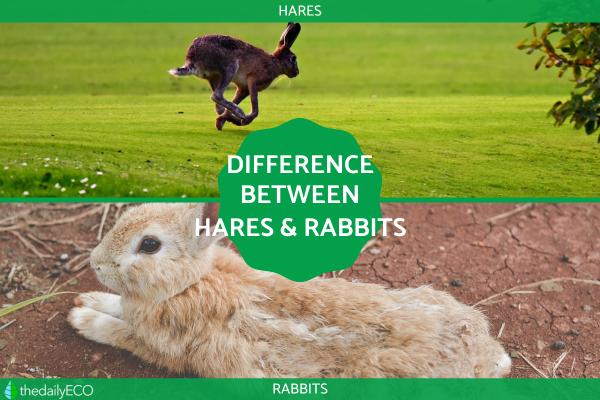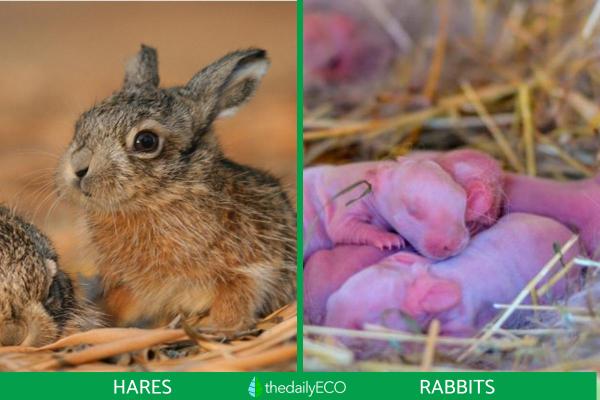Difference Between Rabbits and Hares


The differences between rabbits and hares are present in both their physical appearance and behaviors, despite their many similarities. Such similarities are understandable given the fact they are very closely related in the family Leporidae, but sufficiently distinct to be part of different genera. While a cursory glance can make these animals appear very similar, those who know the differences between hares vs. rabbits will quickly be able to know which is which.
It is for this reason thedailyECO explains the difference between rabbits and hares. We do so by sharing their characteristics, as well as photos of the two lagomorphs to see for yourself. In doing so, you will be the kind of expert who can tell these animals apart easily.
Difference between rabbits and hares
Rabbits and hares both belong to the order Lagomorpha, a distinction they share with the stockier pika. As small mammals, they share many similarities which we will explain below. Before we do, we look at the main differences between hares vs. rabbits:
Size
While it can be difficult to tell from photos alone, size is perhaps the easiest way to differentiate between hares and rabbits. Hares are generally much larger than rabbits. A hare can reach 27.5"/70 cm, while rabbits usually range 20-23.5"/50-60 cm. Hares also average around 8.8 lb/4 kg, whereas rabbits are only about 4.4 lb/2 kg.
The above values refer to wild rabbits and hares, but there is much greater range in size of rabbits due to the existence of a large number of domestic breeds. These include giant rabbit breeds such as the Flemish Giant which has been bred to weigh up to 22 lb/10 kg.
The existence of domestic breeds in rabbits is also an important difference between rabbits and hares. This is because hares have not been domesticated. Rabbits have their own domestic species which is the domestic form of the European rabbit (Oryctolagus cuniculus).
Morphology
The next main difference between rabbits and hares has to do with their morphology, i.e. their body shape. Some of the most noticeable differences are:
- Ears: the ears of rabbits are much smaller in size than the ears of hares, which can exceed 4.3"/11 cm in length.
- Legs: the legs of hares are much longer and more slender if we compare them to rabbits, with shorter and rounder bodies.
You may wonder whether hares are faster than rabbits. As the famous fairy tale goes, it is the hare who races the tortoise. This is appropriate because the longer legs, lighter bodies and greater musculature of hares means they can reach speeds of over 37 mph/60 kph. This doesn't rabbits are not fast, but the hare is likely to beat them in a sprint.
Young
Both animals also show very important differences in their newborn kits. The differences between newborn hares and rabbits are to do with whether they are:
- Altricial: rabbits are born at a very low stage of development. They are deaf, blind and have no hair or ability to regulate their body temperature, so they are totally dependent on their mother.
- Precocial: hare kits are more developed and are able to move on their own in a very short time. In addition, the gestation period of hares is 42 days, while that of rabbits is 30. This accounts for difference in development at birth.
In the photo below we show the great difference between recently born hare and rabbit kits.
Habits and behavior
The main differences on this point is that hares are wild animals that do not tolerate living in confined spaces. Rabbits are both domesticated and wild animals, meaning some have adapted to living with humans.
In their natural habitat, hares build their nests in areas of flattened grass or at ground level. They live in open spaces, they are solitary and they protect themselves from their predators with their greatest asset, their speed. Rabbits are gregarious animals that make their nests and burrows underground, hiding from threats. For this reason, in natural environments it is much easier to see hares than rabbits.
Additionally, hares tend to alert or communicate with each other using high-pitched squeals or growls. They also gnash their teeth. Conversely, rabbits are less likely to produce sounds, communicating by thumping their feet against the ground.
After knowing the difference between a rabbit and a hare, you might want to learn a little about the differences in other similar mammals. This is the case with our comparison of the differences between wolves and coyotes.

Similarities between rabbits vs. hares
As we have said before, although there are several differences between the rabbit and the hare, they are animals that come from the same taxonomic family. However, their similarities are greater than just taxonomy. The similarities between rabbits and hares include:
- Order: they are lagomorphic mammals, of the Leporidae family.
- Physical features: they have very similar basic physical features, although their size or shape mean they also include some of their main differential points, such as ears and legs.
- Diet: both animals are herbivores.
- Use of the hind legs: they can take great leaps with their hind legs.
- Reproduction: they are prolific breeders, capable of having up to eight litters a year and with several young per litter.
Check out other comparisons of similar animals with the differences between crocodiles and alligators.
Characteristics of hares
After talking about the differences between hares and rabbits and some of their similarities, we want to indicate what are the main characteristics of hares:
- Number of species: there are 32 species of hare which are the only members of the genus Lepus.
- Distribution: they are widespread through the areas of Europe, Asia, North America and Africa.
- Athleticism: as you can see in the photo, they are characterized by their great running speed and their ability to jump up to 3 meters away. Their maximum speeds and distances vary depending on the specific species.
- Mating: in spring they carry out their courtship and mating rituals which include fighting between males hitting each other with their front legs and then chasing the females in a race.
- Pets: they are not domestic animals like rabbits, but they are eaten as food by many cultures.

Characteristics of rabbits
To finish our comparison of the differences between rabbits and hares, we can look at the characteristics of rabbits, pictured in the photo below:
- Number of species: all members of Leporidae that do not belong to the genus Lepus are rabbits. Within these 10 genera are 29 individual species, although there are many different breeds of domestic rabbit.
- Pets: today's domestic rabbits are all descended from the European or common rabbit (Oryctolagus cuniculus).
- Invasive species: the rabbit is an invasive species in various places due to its enormous capacity for reproduction and adaptation, Australia being one of the countries where it has caused the most damage.
- Size: the different species of rabbits present great variations in their sizes, although they usually measure between 11.8-19.5"/30-50 cm in length in the wild.
- Distribution: rabbits are widespread in Africa, Europe, Russia, Australia, South Africa and the Americas.
- Farming: they avoid modern crop fields which destroy their burrows, but adapt to other environments such as parks.
- Diet: rabbits sometimes digest food in two phases. They can digest their food and then excrete it in pellets. They may then eat some of thee pellets which are known as cecotropes which provide additional nutrition. Not all rabbit droppings and be redigested.
The last comparison we share is the differences between alpacas and lamas.

If you want to read similar articles to Difference Between Rabbits and Hares, we recommend you visit our Facts about animals category.








